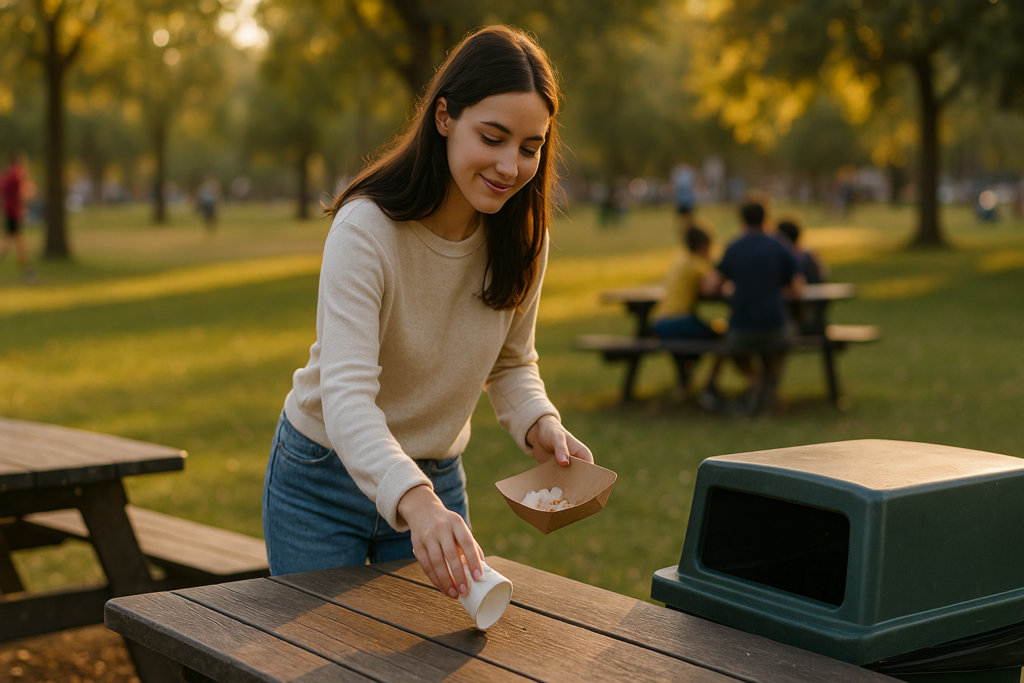Watch two diners leave the same food-court table. One walks off, crumbs scattered. The other pauses, folds the napkins, stacks the trays, gives the surface a quick swipe, then pushes the chairs in. That moment—maybe five seconds long—reveals far more than a preference for cleanliness.
Across dozens of field experiments and personality studies, psychologists have found that people who habitually tidy shared spaces score higher on self-control, empathy, moral identity, and sensitivity to social norms.
Their behavior predicts everything from civic engagement to mental health.
Below are seven standout habits that cluster around these public-space cleaners—and the science that backs each one.
1. They detect norm violations faster than most
Robert Cialdini’s classic “focus theory of normative conduct” showed that seeing a single piece of litter in an otherwise clean setting primes people to dispose of their own trash properly—because the lone violation pops against the norm.
High self-cleaners appear to live in this heightened state all the time: they notice the sticky soda ring, the overstuffed bin, or the chair knocked askew before others do.
Functional-MRI work (e.g., increased anterior cingulate activity when neat freaks view disorder) suggests their brains treat mess as a cognitive error signal. Spotting a violation triggers a mild discomfort that only action can resolve, explaining why they leap up to fix a spill no one else saw.
2. They run on “if-then” implementation intentions
Cleaning up isn’t spontaneous; it’s scripted. Peter Gollwitzer’s research on implementation intentions found that forming simple if-then plans (e.g., “If I finish my drink, then I’ll find a recycling bin”) almost doubles follow-through on prosocial tasks
Habitual in-public cleaners seem to preload dozens of micro-plans: they carry reusable totes, tuck tissues in pockets, and mentally link end of meal with wipe the table.
Over time the cue triggers the action automatically, so tidying feels effortless instead of virtuous.
3. Their conscientiousness comes with a communal twist
In the Big-Five model, orderliness is a sub-facet of conscientiousness—but most studies gauge it in private domains (tidy desks, well-organized calendars).
Samuel Gosling’s “room-with-a-cue” project showed external observers can accurately guess a person’s conscientiousness just by inspecting their bedroom or office.
Public-space cleaners take that private preference and bolt on agreeableness. They aren’t merely neat; they feel obligated to keep shared environments orderly.
Sociologist Dirk Stegeman labels this blend public mindfulness: the sense that one’s personal tidiness standards should ripple outward for everyone’s benefit.
4. They fuse vicarious disgust with empathy
Jonathan Haidt’s work on disgust sensitivity uncovered wide individual differences: for some, a sticky countertop can trigger the same neural circuitry that fires when encountering rotten food.
Yet disgust alone makes people avoid mess, not clean it.
Tidy-uppers pair that gut-level “eww” with empathic concern (“Someone could slip on this”).
In lab studies, participants high in both disgust sensitivity and empathy were three times more likely to sanitize a table that a stranger had soiled. The dual emotion turns revulsion into constructive action instead of withdrawal.
5. They act as silent norm entrepreneurs
Kees Keizer and colleagues famously scattered graffiti and flyers around Dutch alleyways; when signs of disorder were present, littering, trespassing, and even petty theft soared.
The inverse also holds: a single bystander who restores order lowers subsequent norm violations by almost half.
Public-space cleaners intuitively understand this “broken windows” reciprocity.
By quietly returning a shopping cart or righting a toppled sign, they broadcast a subtle but powerful message—this place is cared for, so care for it.
Social-identity theory predicts that because they see themselves as “quiet custodians,” their future behavior (and often that of onlookers) stays consistent with that identity.
6. They train self-control like a muscle—and know how to refuel it
The traditional ego-depletion model argues self-control draws on a limited resource, so resisting temptation
A makes it harder to resist temptation B. Michael Inzlicht’s mechanistic revision suggests motivation and personal meaning can replenish that resource.
Self-cleaners score high on the Brief Self-Control Scale and report quick “top-ups”: a sip of water, a deep breath, a recall of personal values.
Field research on university students showed those who routinely cleaned communal study desks also binge-watched less and slept more consistently, hinting that their discipline spills across life domains.
7. They believe tiny acts feed collective efficacy
Albert Bandura defined collective efficacy as the shared belief that “together we can make a difference.”
In neighborhoods where residents felt high collective efficacy, visible litter declined even after controlling for income and population density.
For habitual cleaners, tossing one straw wrapper in the bin isn’t about personal virtue; it’s proof that cooperation works. That mindset predicts higher rates of voting, volunteering, and donating. In other words, sweeping crumbs is their micro-version of civil society.
Conclusion: the ripple effect of a wiped table
Taken alone, a quick tidy-up seems trivial. Yet each of the seven behaviors above fuels the next in a virtuous cycle—heightened norm awareness sparks an if-then plan; orderly identity amplifies empathy; collective efficacy keeps self-control stocked.
Over time these micro-gestures accumulate into cleaner parks, friendlier cafés, and neighborhoods where “someone obviously cares.”
Just as one piece of litter can license further mess, one person who refuses to leave a mess can spark a chain reaction toward order.
So the next time you see someone scooping another patron’s breadcrumbs into the trash, remember: you’re witnessing psychology in action—and maybe catching a quiet invitation to join in.







